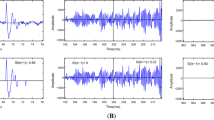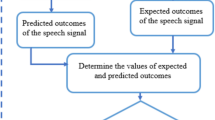Abstract
This contribution addresses the application of Bayesian changepoint detectors (BCD) for the estimation of boundary location between speech units. A novel segmentation approach based on the family of Bayesian detectors using an instantaneous envelope and instantaneous frequency of speech rather than waveform itself is suggested. This approach does not rely on phonetic models, and therefore no supervised training is needed. No apriori information about speech is required, and thus the approach belongs to the class of blind segmentation methods. Due to the small percent of error in signal changepoint location, this method can be also used for tuning boundary location between phonetic categories estimated by other segmentation methods. The average bias between exact boundary location and its estimation is up to 7 ms for real speech.
Preview
Unable to display preview. Download preview PDF.
Similar content being viewed by others
References
Bajwa, R.S., Owens, R.M., Keliher, P.T.: Simultaneous speech segmentation and phoneme recognition using dynamic programming. Proceedings of IEEE International Conference on Acoustic, Speech and Signal Processing, Vol. 6. Atlanta (1996) 3213–3216
Sharma, M., Mammone, R.L.: “Blind” speech segmentation of speech without linguistic knowledge. Proceedings ICLP’96. Fourth International Conference on Spoken Language Processing, Vol. 2. Philadelphia (1996) 1234–40
Jeong, Ch.G., Jeong, H.: Automatic phone segmentation and labeling of continuous speech. Speech Communication 20 (1996) 291–311
Pauws, S., Kamp, Y., Willems, L.: A hiearchical method of automatic speech segmentation for synthetis application. Speech Communication 19 (1996) 207–220
Nakagawa, S., Hashimoto, Y.: A Method for Continuous Speech Segmentation using HMM. In.: 9th International Conference on Pattern Recognition, Roma (1988) 960–962
Nakagawa, S., Hashimoto, Y.: Segmentation of Continuous Speech by HMM and Bayesian Probability. Transactions of he Institute of Electronics, Information and Communication Engineers D-II, Vol. J72D-II 1 (1989) 1–10
Grayden, D.B., Scordilis, M.S.: Phonemic Segmentation of Fluent Speech. In.: International Conference on Acoustics, Speech and Signal Processing, ICASSP-94, Vol. 1 Adelaide (1994) 73–76
Meng, H.M., Zue, V.W.: Signal representation comparison for phonetic classification. In.: International Conference on Acoustics, Speech and Signal Processing, ICASSP-91, Vol.1 Toronto (1991) 285–288
Micallef, P.: Automatic identification of phoneme boundaries using a mixed parameter model. In.: Eurospeech’97. ESCA, Rhodes, (1997) 485–488
Rayner, P.J.W., Fitzgerald, W.J.: The Bayesian Approach to Signal Modelling and Classification. In.: The 1-st European Conference on Signal Analysis and Prediction. ECSAP’97 Prague (1997) 65–75
Ruanaidh, J.K.O., Fitzgerald, W. J.: Numerical Bayesian Methods Applied to Signal Processing. Springer-Verlag, Berlin Heidelberg New York (1996)
Cmejla, R., Sovka, P.: The use of Bayesian Detector in Signal Processing, In.: The IASTED Signal and Image Processing’99. IASTED/ACTA Press, Anaheim Calgary Zurich (1999) 76–80
Wei, W.W.S.: Time Series Analysis: Univariate and Multivariate Methods. Addison-Wesley Publishing Company, Wokingham (1995)
Marple, S.L.: Digital Spectral Analysis with Applications. Prentice-Hall, Englewood Cliffs New Jersey (1987)
Romberg, T.M., Black, J.L., Ledwige, T.J.: Signal Processing for Industrial Diagnostics. John Wiley Chichester (1996)
Pukkila, M.T., Krishnaiah, P.R.: On the Use of Autoregressive Order Determination Criteria in Multivariate White Noise Tests. IEEE Trans. on ASSP, 36(9) (1988) 1396–1403
Schloegel, A.:Time Series Analysis (TSA)Toolbox. http://www-dpmi.tu-graz.ac.at/ schloegl
Cmejla, R., Sovka, P.: Application of Bayesian Autoregressive Detector for Speech Segmentation. In.: The International Conference on Signal Processing, Applications and Technology, ICSPAT’ 99. Miller Freeman Los Angeles (1999) CD-ROM
Kozuchovskaja, I.A.: Evaluation of the precission of speech parameters LPC vocoder. Elektrosvjaz, 4 Moskva (1984) 48–51
Oppenheim, V.A., Shafer, R.V.:Discrete-Time Signal Processing. Prentice Hall, Englewood Clifs New Jersey (1990)
Author information
Authors and Affiliations
Editor information
Editors and Affiliations
Rights and permissions
Copyright information
© 2001 Springer-Verlag Berlin Heidelberg
About this paper
Cite this paper
Čmejla, R., Sovka, P. (2001). Estimation of Boundaries between Speech Units Using Bayesian Changepoint Detectors. In: Matoušek, V., Mautner, P., Mouček, R., Taušer, K. (eds) Text, Speech and Dialogue. TSD 2001. Lecture Notes in Computer Science(), vol 2166. Springer, Berlin, Heidelberg. https://doi.org/10.1007/3-540-44805-5_39
Download citation
DOI: https://doi.org/10.1007/3-540-44805-5_39
Published:
Publisher Name: Springer, Berlin, Heidelberg
Print ISBN: 978-3-540-42557-1
Online ISBN: 978-3-540-44805-1
eBook Packages: Springer Book Archive




